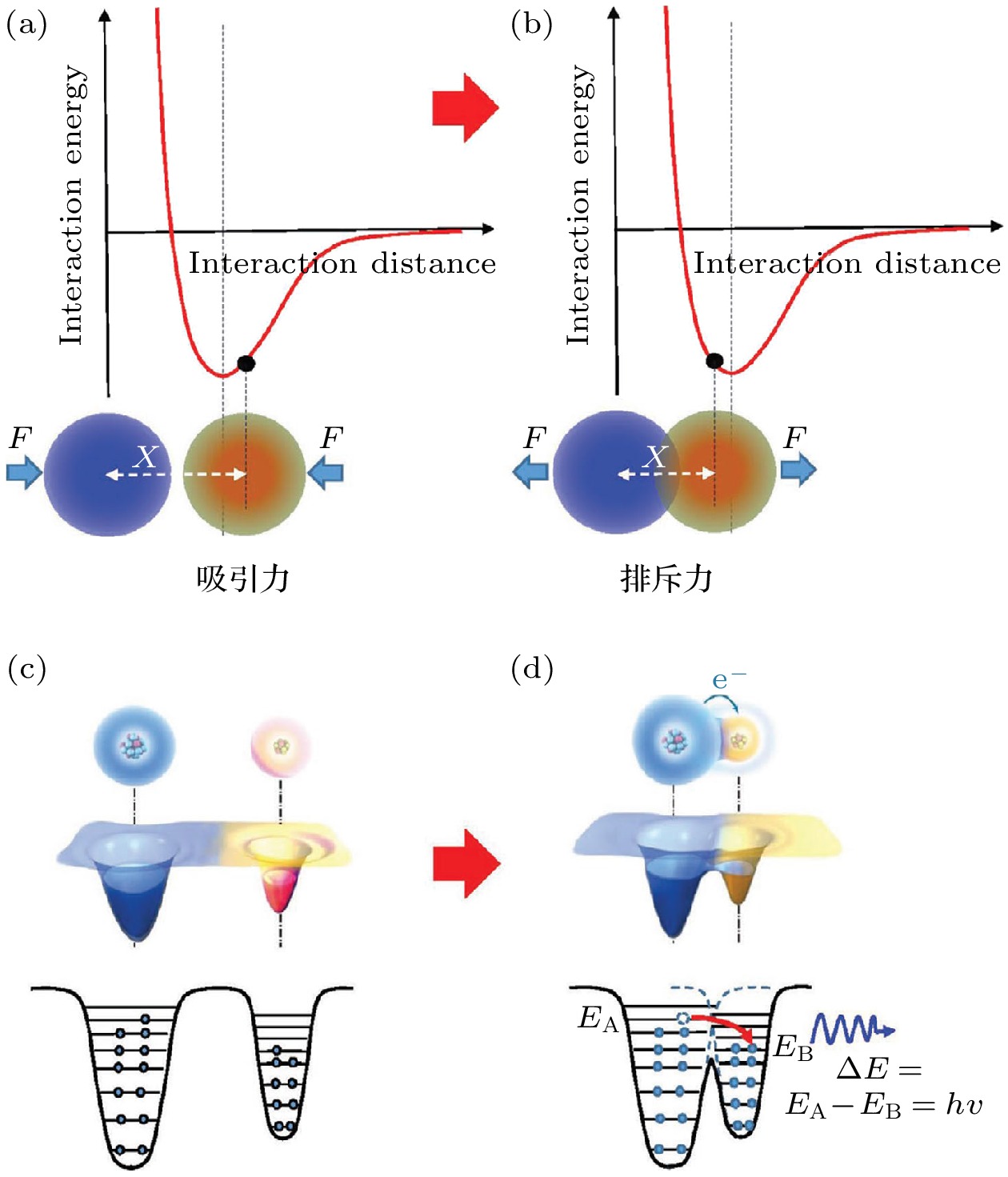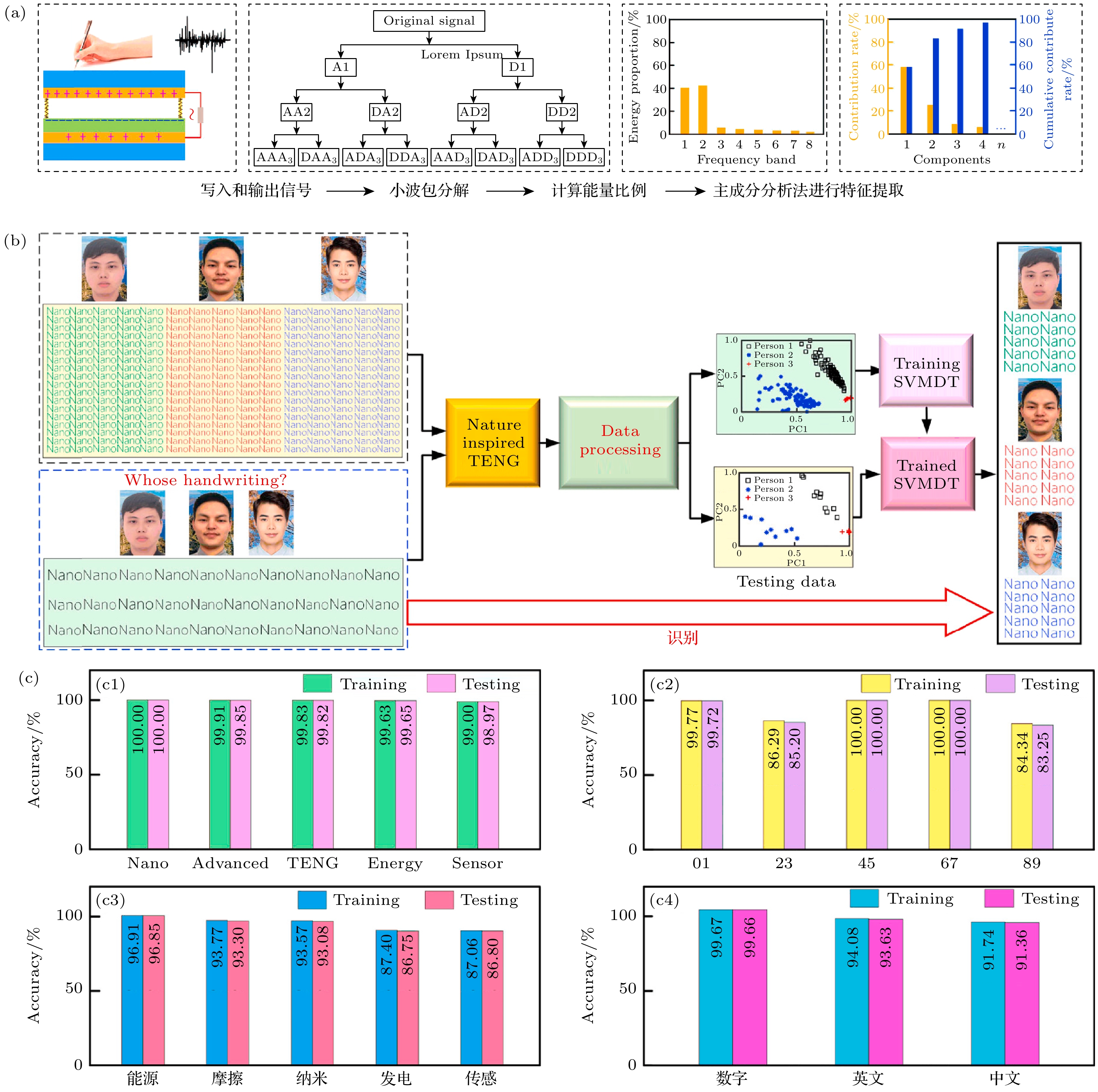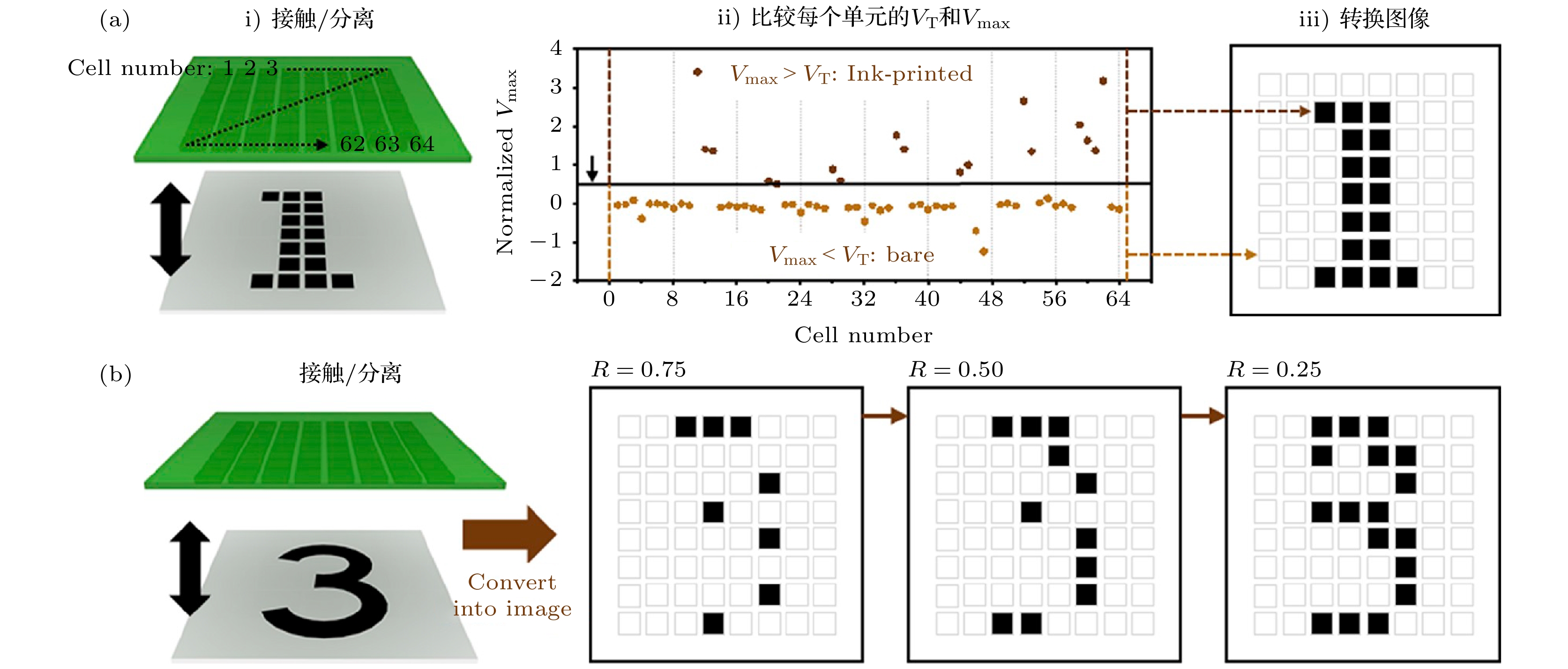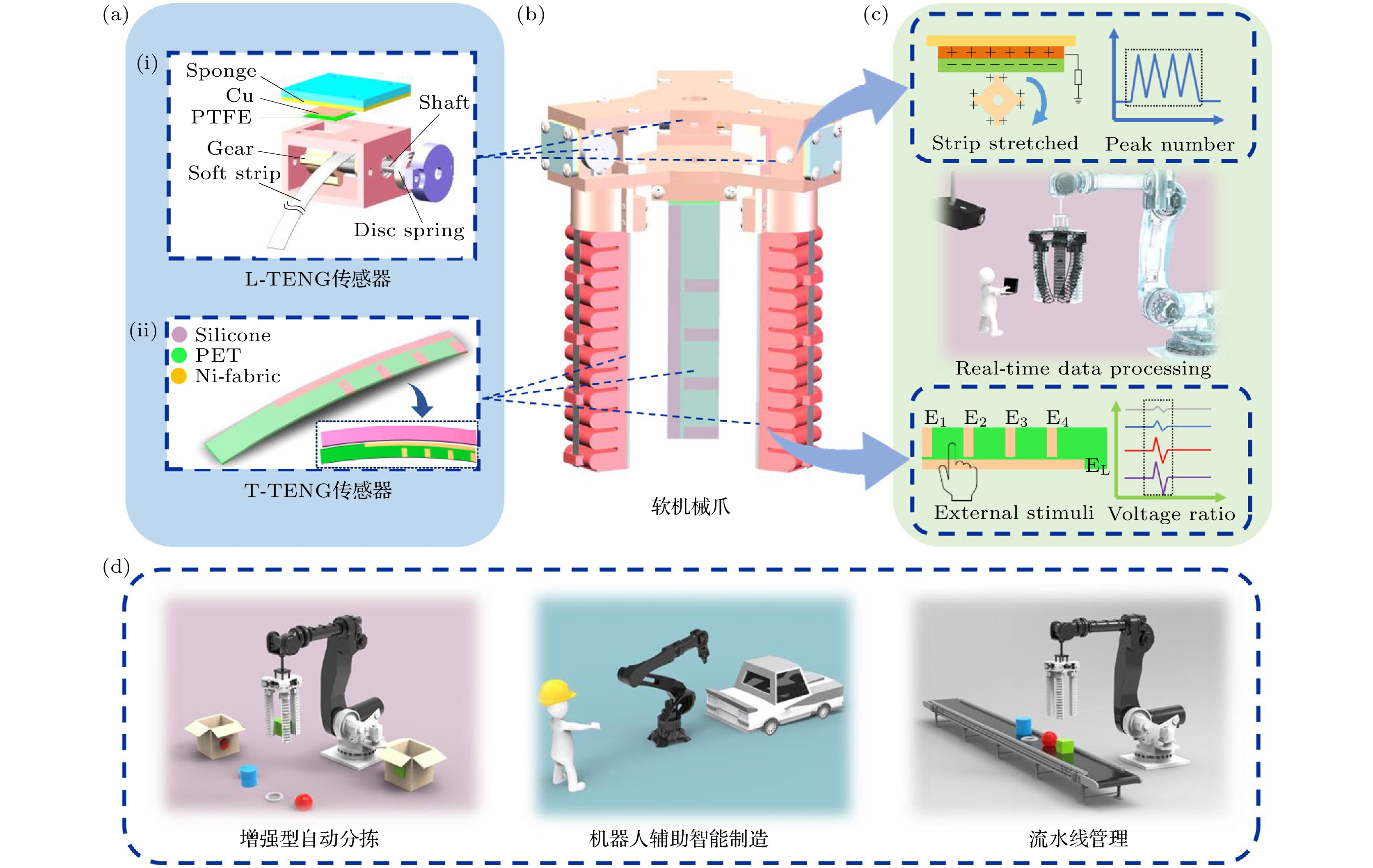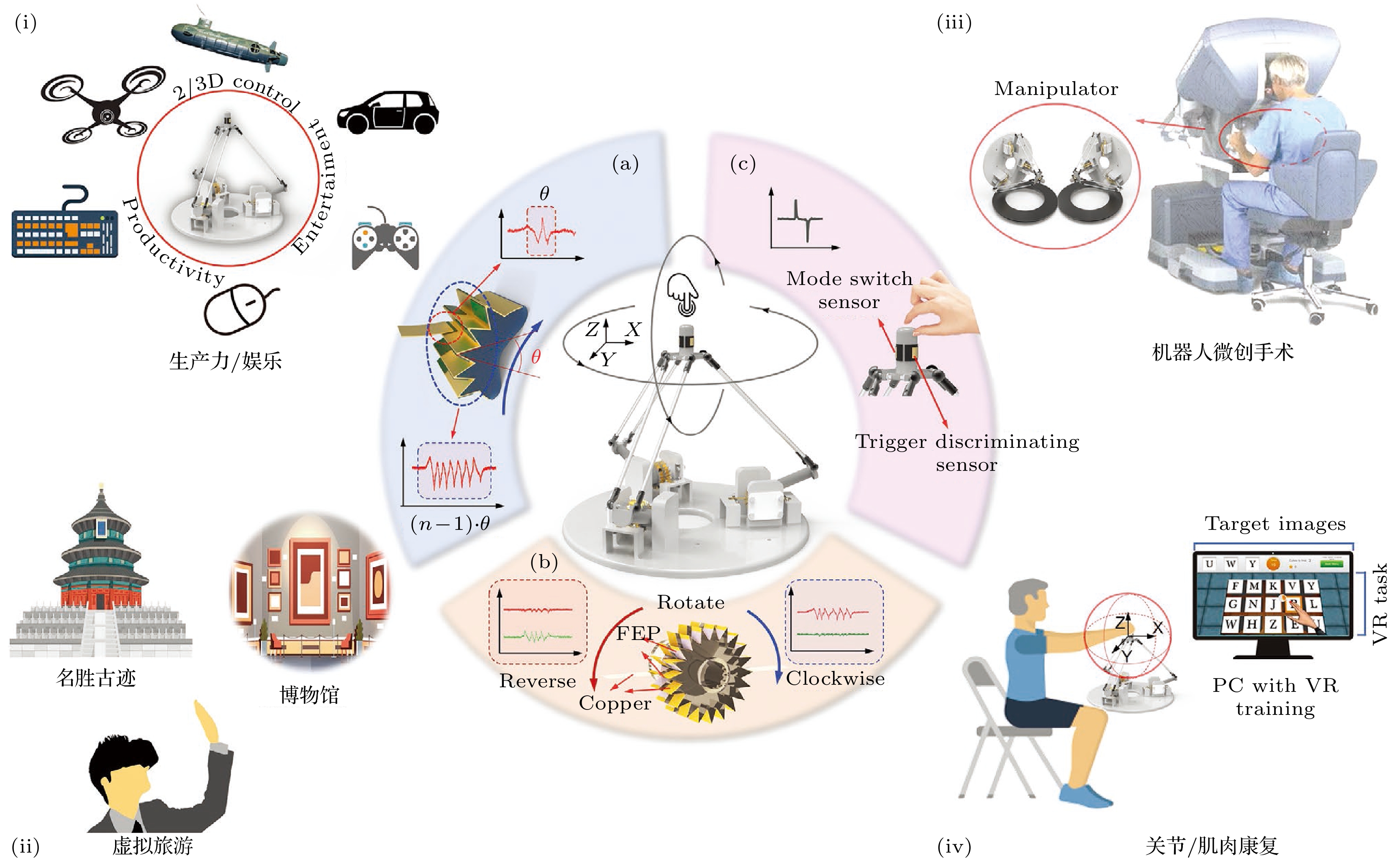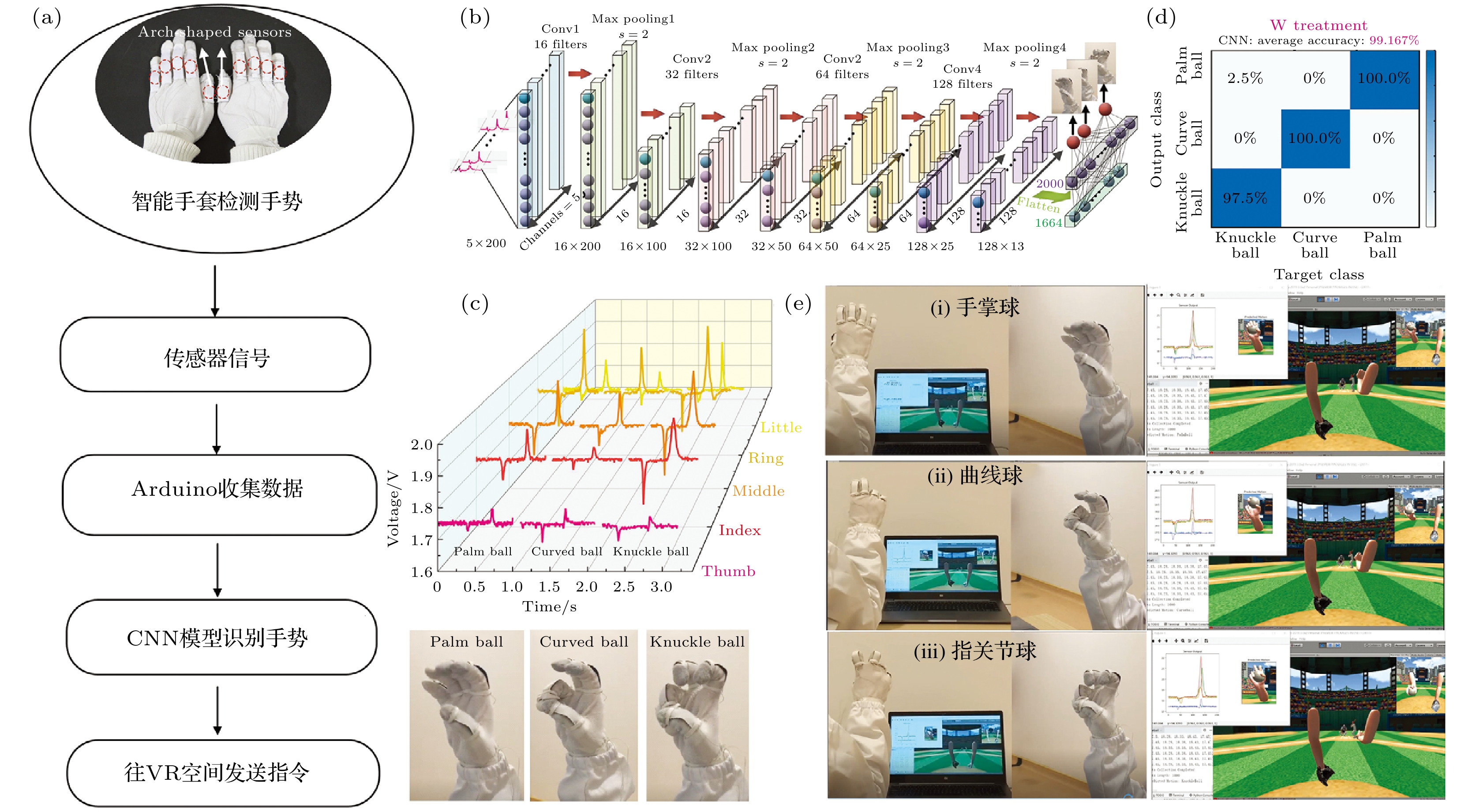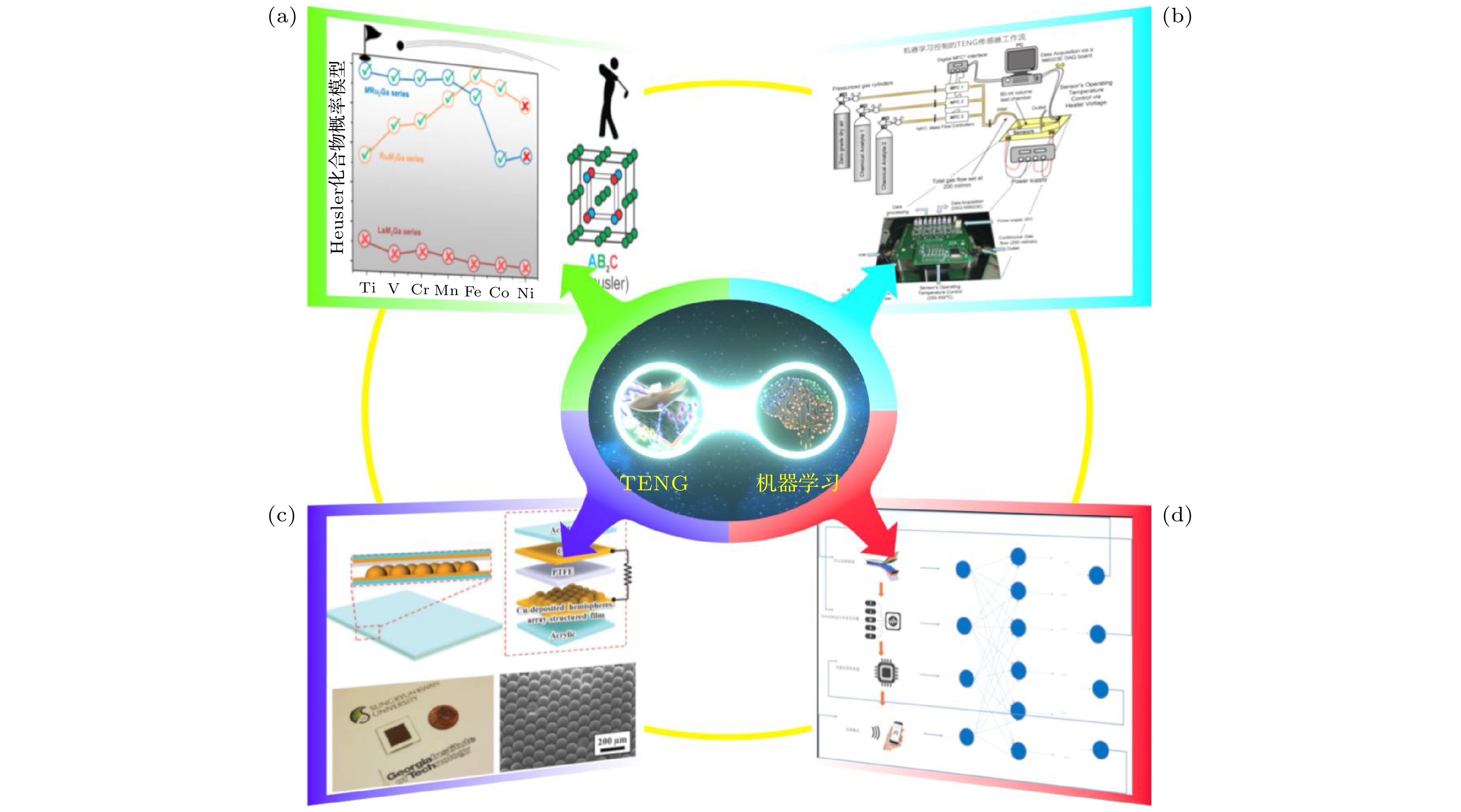-
在物联网时代, 如何开发一种可持续供电、部署方便且使用灵活的智能传感器系统成为了亟待解决的难题. 以麦克斯韦位移电流作为驱动力的摩擦纳米发电机(triboelectric nanogenerator, TENG)可直接将机械刺激转化为电信号, 因此可作为自驱动传感器使用. 基于TENG的传感器拥有结构简单、瞬时功率密度高等优点, 为构建智能传感器系统提供了重要手段. 同时, 机器学习作为一种成本低、开发周期短、数据处理能力和预测能力强的技术, 对TENG产生的大量电学信号处理效果显著. 本文梳理了基于TENG的传感器系统通过采用机器学习技术进行信号处理和智能识别的最新研究进展, 从交通安全、环境监测、信息安全、人机交互和健康运动检测等角度出发, 概述了该研究方向的技术特点与研究现状. 最后, 深入讨论了该领域当前存在的挑战和未来的发展趋势, 并分析了未来如何改进以期开拓更广阔的应用空间. 我们相信机器学习技术与TENG传感器的结合将推动未来智能传感器网络的快速发展.In the era of The Internet of Things, how to develop a smart sensor system with sustainable power supply, easy deployment and flexible use has become an urgent problem to be solved. Triboelectric nanogenerator (TENG) driven by Maxwell’s Displacement Current can convert mechanical motion into electrical signals, thus it can be used as a self-powered sensor. Sensors based on TENGs have the advantages of simple structure and high instantaneous power density, which provide an important means to build intelligent sensor systems. Meanwhile, machine learning, as a technique with low cost, short development cycle, and strong data processing capabilities and predictive capabilities, is effective in processing the large amount of electrical signals generated by TENG. This article combines the latest research progress of TENG-based sensor systems for signal processing and intelligent recognition by employing machine learning techniques, and outlines the technical features and research status of this research direction from the perspectives of traffic safety, environmental monitor, information security, human-computer interaction and health motion detection. Finally, this article also in-depth discusses the current challenges and future development trends in this field, and analyzes how to improve in the future to open up a broader application space. It is suggested that the integration of machine learning technology and TENG-based sensors will promote the rapid development of intelligent sensor networks in the future.
-
Keywords:
- internet of things /
- triboelectric nanogenerator /
- sensor /
- machine learning
[1] 解运洲 2020 物联网技术 10 4
Xie Y Z 2020 Internet Things Technol. 10 4
[2] Portilla J, Mujica G, Lee J S, Riesgo T 2019 IEEE Sens. J. 19 3179
 Google Scholar
Google Scholar
[3] Lin R, Kim H J, Achavananthadith S, Kurt S A, Tan S C, Yao H, Tee B C, Lee J K, Ho J S 2020 Nat. Commun. 11 444
 Google Scholar
Google Scholar
[4] Fan F R, Tian Z Q, Wang Z L 2012 Nano Energy 1 328
[5] Alagumalai A, Mahian O, Aghbashlo M, Tabatabaei M, Wongwises S, Wang Z L 2021 Nano Energy 83 105844
 Google Scholar
Google Scholar
[6] 王中林, 林龙, 陈俊, 牛思淼, 訾云龙 2017 摩擦纳米发电机 (北京: 科学出版社) 第11页
Wang Z L, Lin L, Chen J, Niu S M, Zi Y L 2017 Triboelectric Nanogenerators (Beijing: China Science Publishing & Media) p11 (in Chinese)
[7] 吴晔盛, 刘启, 曹杰, 李凯, 程广贵, 张忠强, 丁建宁, 蒋诗宇 2019 物理学报 68 190201
 Google Scholar
Google Scholar
Wu Y S, Liu Q, Cao J, Li K, Cheng G G, Zhang Z Q, Ding J N, Jiang S Y 2019 Acta Phys. Sin. 68 190201
 Google Scholar
Google Scholar
[8] McCarthy J, Feigenbaum E A 1990 AI Mag. 11 10
[9] Fan F R, Tian Z Q, Wang Z L 2012 Nano Energ. 1 328
[10] Niu S, Wang Z L 2015 Nano Energy 14 161
 Google Scholar
Google Scholar
[11] Luo J, Wang Z L 2020 EcoMat 2 e12059
[12] Li S, Nie J, Shi Y, Tao X, Wang F, Tian J, Lin S, Chen X, Wang Z L 2020 Adv. Mater. 32 2001307
 Google Scholar
Google Scholar
[13] Nie J, Ren Z, Xu L, Lin S, Zhan F, Chen X, Wang Z L 2020 Adv. Mater. 32 1905696
 Google Scholar
Google Scholar
[14] Wang Z L 2017 Mater. Today 20 74
 Google Scholar
Google Scholar
[15] Wang Z L 2013 ACS Nano 7 9533
 Google Scholar
Google Scholar
[16] Nie J, Wang Z, Ren Z, Li S, Chen X, Wang Z L 2019 Nat. Commun. 10 2264
 Google Scholar
Google Scholar
[17] Wang S, Lin L, Wang Z L 2012 Nano Lett. 12 6339
 Google Scholar
Google Scholar
[18] Zhu G, Lin Z H, Jing Q, Bai P, Pan C, Yang Y, Zhou Y, Wang Z L 2013 Nano Lett. 13 847
 Google Scholar
Google Scholar
[19] Niu S, Wang S, Liu Y, Zhou Y S, Lin L, Hu Y, Pradel K C, Wang Z L 2014 Energy Environ. Sci. 7 2339
 Google Scholar
Google Scholar
[20] Zhu G, Chen J, Liu Y, Bai P, Zhou Y S, Jing Q, Pan C, Wang Z L 2013 Nano Lett. 13 2282
 Google Scholar
Google Scholar
[21] Wang S, Lin L, Xie Y, Jing Q, Niu S, Wang Z L 2013 Nano Lett. 13 2226
 Google Scholar
Google Scholar
[22] Lei R, Shi Y, Ding Y, Nie J, Li S, Wang F, Zhai H, Chen X, Wang Z L 2020 Energy Environ. Sci. 13 2178
 Google Scholar
Google Scholar
[23] Bai P, Zhu G, Liu Y, Chen J, Jing Q, Yang W, Ma J, Zhang G, Wang Z L 2013 ACS Nano 7 6361
 Google Scholar
Google Scholar
[24] Niu S, Zhou Y S, Wang S, Liu Y, Lin L, Bando Y, Wang Z L 2014 Nano Energy 8 150
 Google Scholar
Google Scholar
[25] Wang S, Niu S, Yang J, Lin L, Wang Z L 2014 ACS Nano 8 12004
 Google Scholar
Google Scholar
[26] Wu C, Wang A C, Ding W, Guo H, Wang Z L 2019 Adv. Energy Mater. 9 1802906
 Google Scholar
Google Scholar
[27] Cortes C, Vapnik V 1995 Mach. Learn. 20 273
[28] Kukreja H, Bharath N, Siddesh C, Kuldeep S 2016 Int. J. Adv. Res. Innov. Ideas Educ. 1 27
[29] 李彦冬, 郝宗波, 雷航 2016 计算机应用 36 2508
Li Y, Hao Z, Lei H 2016 J. Comput. Appl. 36 2508
[30] Greff K, Srivastava R K, Koutník J, Steunebrink B R, Schmidhuber J 2016 IEEE Trans. Neural Netw. Learn. Syst. 28 2222
[31] Hinton G E, Osindero S, Teh Y W 2006 Neural Comput. 18 1527
 Google Scholar
Google Scholar
[32] Butler A C 2010 J. Exp. Psychol. Learn. Mem. Cogn. 36 1118
 Google Scholar
Google Scholar
[33] Wang B, Liu Y, Zhou Y, Wen Z 2018 Nano Energy 46 322
 Google Scholar
Google Scholar
[34] Peden M 2005 Int. J. Inj. Control Saf. Promot. 12 85
 Google Scholar
Google Scholar
[35] Abou Elassad Z E, Mousannif H, Al Moatassime H 2020 Transp. Res. Part C Emerg. Technol. 118 102708
 Google Scholar
Google Scholar
[36] Soares S, Monteiro T, Lobo A, Couto A, Cunha L, Ferreira S 2020 Sustainability 12 1971
 Google Scholar
Google Scholar
[37] Moretti L, Palazzi F, Cantisani G 2020 Sustainability 12 4120
 Google Scholar
Google Scholar
[38] Trivedi M M, Cheng S Y 2007 Computer 40 60
[39] Trivedi M M, Gandhi T, McCall J 2007 IEEE Trans. Intell. Transp. Syst. 8 108
 Google Scholar
Google Scholar
[40] Zhang H, Cheng Q, Lu X, Wang W, Wang Z L, Sun C 2021 Nano Energy 79 105455
 Google Scholar
Google Scholar
[41] Ho T K 1995 Proceedings of 3rd international conference on document analysis and recognition Montreal Montreal, QC, Canada, August 14–16,1995 p278
[42] Wu Y, Abdel-Aty M, Park J, Zhu J 2018 Transp. Res. Part C Emerg. Technol. 95 481
 Google Scholar
Google Scholar
[43] Cheng Q, Jiang X, Zhang H, Wang W, Sun C 2020 Sustainability 12 8926
 Google Scholar
Google Scholar
[44] Ma C, Gao S, Gao X, Wu M, Wang R, Wang Y, Tang Z, Fan F, Wu W, Wan H, Wu W 2019 InfoMat 1 116
 Google Scholar
Google Scholar
[45] García-Gonzalo E, Fernández-Muñiz Z, García Nieto P J, Bernardo Sánchez A, Menéndez Fernández M 2016 Materials 9 531
 Google Scholar
Google Scholar
[46] Zhang W, Wang P, Sun K, Wang C, Diao D 2019 Nano Energy 56 277
 Google Scholar
Google Scholar
[47] Yang L, Wang Y, Zhao Z, Guo Y, Chen S, Zhang W, Guo X 2020 ACS Appl. Mater. Interfaces 12 38192
 Google Scholar
Google Scholar
[48] Fukushima K 1980 Biol. Cybern. 36 193
 Google Scholar
Google Scholar
[49] Shao H, Jiang H, Li X, Liang T 2018 Comput. Ind. 96 27
 Google Scholar
Google Scholar
[50] Zhao G, Yang J, Chen J, Zhu G, Jiang Z, Liu X, Niu G, Wang Z L, Zhang B 2019 Adv. Mater. Technol. 4 1800167
 Google Scholar
Google Scholar
[51] Zhang W, Deng L, Yang L, Yang P, Diao D, Wang P, Wang Z L 2020 Nano Energy 77 105174
 Google Scholar
Google Scholar
[52] Tcho I W, Kim W G, Choi Y K 2020 Nano Energy 70 104534
 Google Scholar
Google Scholar
[53] Jin T, Sun Z, Li L, Zhang Q, Zhu M, Zhang Z, Yuan G, Chen T, Tian Y, Hou X, Lee C 2020 Nat. Commun. 11 5381
 Google Scholar
Google Scholar
[54] Shi Y, Wang F, Tian J, Li S, Fu E, Nie J, Lei R, Ding Y, Chen X, Wang Z L 2021 Sci. Adv. 7 eabe2943
 Google Scholar
Google Scholar
[55] Hou C, Geng J, Yang Z, Tang T, Sun Y, Wang F, Liu H, Chen T, Sun L 2021 Adv. Mater. Technol. 6 2000912
 Google Scholar
Google Scholar
[56] Zhang Z, He T, Zhu M, Sun Z, Shi Q, Zhu J, Dong B, Yuce M R, Lee C 2020 NPJ Flex. Electron. 4 29
 Google Scholar
Google Scholar
[57] Wen F, Sun Z, He T, Shi Q, Zhu M, Zhang Z, Li L, Zhang T, Lee C 2020 Adv. Sci. 7 2000261
 Google Scholar
Google Scholar
[58] Lin Z, Wu Z, Zhang B, Wang Y C, Guo H, Liu G, Chen C, Chen Y, Yang J, Wang Z L 2019 Adv. Mater. Technol. 4 1800360
 Google Scholar
Google Scholar
[59] Luo J, Gao W, Wang Z L 2021 Adv. Mater. 33 2004178
 Google Scholar
Google Scholar
[60] Liu S, Zhang J, Zhang Y, Zhu R 2020 Nat. Commun. 11 5615
 Google Scholar
Google Scholar
[61] Luo J, Wang Z, Xu L, Wang A C, Han K, Jiang T, Lai Q, Bai Y, Tang W, Fan F R, Wang Z L 2019 Nat. Commun. 10 5147
 Google Scholar
Google Scholar
[62] Zhou Y, Shen M, Cui X, Shao Y, Li L, Zhang Y 2021 Nano Energy 84 105887
 Google Scholar
Google Scholar
[63] Syu M H, Guan Y J, Lo W C, Fuh Y K 2020 Nano Energy 76 105029
 Google Scholar
Google Scholar
[64] Shi Q, Zhang Z, He T, Sun Z, Wang B, Feng Y, Shan X, Salam B, Lee C 2020 Nat. Commun. 11 4609
 Google Scholar
Google Scholar
[65] Shi Q, Zhang Z, Yang Y, Shan X, Salam B, Lee C 2021 ACS Nano 15 18312
 Google Scholar
Google Scholar
[66] Li S, Fan Y, Chen H, Nie J, Liang Y, Tao X, Zhang J, Chen X, Fu E, Wang Z L 2020 Energy Environ. Sci. 13 896
 Google Scholar
Google Scholar
[67] Zou H, Guo L, Xue H, Zhang Y, Shen X, Liu X, Wang P, He X, Dai G, Jiang P, Zheng H, Zhang B, Xu C, Wang Z L 2020 Nat. Commun. 11 2093
 Google Scholar
Google Scholar
[68] Oliynyk A O, Antono E, Sparks T D, Ghadbeigi L, Gaultois M W, Meredig B, Mar A 2016 Chem. Mater. 28 7324
 Google Scholar
Google Scholar
[69] Ward L, Agrawal A, Choudhary A, Wolverton C 2016 NPJ Comput. Mater. 2 16028
 Google Scholar
Google Scholar
[70] Vergara A, Vembu S, Ayhan T, Ryan M A, Homer M L, Huerta R 2012 Sens. Actuators, B 166 320
[71] Gu L, Cui N, Liu J, Zheng Y, Bai S, Qin Y 2015 Nanoscale 7 18049
 Google Scholar
Google Scholar
[72] Lee K Y, Yoon H J, Jiang T, Wen X, Seung W, Kim S W, Wang Z L 2016 Adv. Energy Mater. 6 1502566
 Google Scholar
Google Scholar
[73] Agrawal A, Lee S K, Silberman J, Ziegler M, Kang M, Venkataramani S, Cao N, Fleischer B, Guillorn M, Cohen M, Mueller S, Oh J, Lutz M, Jung J, Koswatta S, Zhou C, Zalani V, Bonanno J, Casatuta R, Chen C Y, Choi J, Haynie H, Herbert A, Jain R, Kar M, Kim K H, Li Y, Ren Z, Rider S, Schaal M, Schelm K, Scheuermann M, Sun X, Tran H, Wang N, Wang W, Zhang X, Shah V, Curran B, Srinivasan V, Lu P F, Shukla S, Chang L, Gopalakrishnan K 2021 IEEE J Solid-State Circuits San Francisco, California, USA, Feburary, 13–22, 2021 p144
[74] Joung H A, Ballard Z S, Wu J, Tseng D K, Teshome H, Zhang L, Horn E J, Arnaboldi P M, Dattwyler R J, Garner O B, Di Carlo D, Ozcan A 2019 ACS Nano 14 229
-
图 5 从基于TENG的传感器收集数据并推送至机器学习模型进行计算分析的过程. 数据在数据中心存储和管理, 用户可以从控制中心与数据中心进行交互. 在预处理阶段将数据分为多元时间序列和多元空间数据, 接着输入机器学习模型分析并做出预测, 最后对结果进行验证和评估
Fig. 5. Process of collecting data from TENG-based sensors and pushing it to the machine learning model for computational analysis. Data is stored and managed in the data center. Users can interact with the data center from the control center. In the preprocessing stage, the data is divided into multivariate time series and multivariate spatial data, and then input into the machine. The machine learns the model and analyzes and makes predictions, and finally verifies and evaluates the results
图 7 实验平台和TENGs的插图 (a)实验平台; (b)放置在方向盘上的两个TENGs, 尺寸为25 cm × 2 cm × 0.1 cm; (c) 反应时间示意图; (d) RF分类器给出的分类结果的混淆矩阵[40]
Fig. 7. Illustrations of experimental platform and TENGs: (a) Experimental platform; (b) two TENGs placed on steering wheel with a size of 25 cm × 2 cm × 0.1 cm. (c) Schematic diagram of reaction time; (d) confusion matrices of the classification result given by RF classifier[40].
图 9 实时沉积物监测的实验装置和工作机理图 (a) 测试装置示意图; (b)去离子水滴和质量分数为1.00%的含颗粒水滴(颗粒直径117.33 μm) 产生的典型输出短路电流, 插图显示了使用高速摄像机捕捉到的液滴的动态运动; (c)水与PTFE接触通电产生主要电流峰的机理; (d)预带电砂粒与铜电极间静电感应产生小电流峰的机理[47]
Fig. 9. Diagram of the experimental setup and working mechanism for real-time sediment monitoring: (a) Schematic diagram of the testing setup. (b) Typical output short-circuit current generated by DI water droplets and particle-laden droplets (particle diameter: 117.33 μm) with a mass fraction of 1.00%. The inset figures show the dynamic motions of the droplets captured using a high-speed camera. (c) Mechanism of the major current peaks induced by the contact electrification between water and PTFE. (d) Mechanism of the minor current peaks induced by the electrostatic induction between the precharged sand particles and the Cu electrode[47].
图 10 智能键盘的工作原理 (a)当用户开始击键, 带正电的手指接近导致自由电子从底部ITO电极流到顶部电极; (b)手指抬起并发生分离时, 会产生反方向从顶部电极流向底部电极的电流[50]
Fig. 10. Operating principle of the intelligent keyboard: (a) When a keystroke is initiated, the approach of positively charged human finger results in free electrons flowing from bottom ITO electron to top electrode; (b) when the finger is up and a separation occurs, it produces another current in the external circuit flowing from the top electrode to bottom electrode[50].
图 11 TENG在手写识别中的应用 (a) TENG录制手写签名的过程; (b)结合TENG和机器学习方法进行手写签名识别; (c) 由三人书写英文、中文和阿拉伯数字的分类精度[51]
Fig. 11. Application of TENG in handwriting recognition: (a) Process of TENG recording handwritten signatures; (b) combining TENG and machine learning methods for handwriting signature recognition; (c) classification accuracy of English, Chinese and Arabic numerals written by three persons[51]
图 12 CR-TENG的工作原理图 (a) 基于CR-TENG的扫描过程: i) CR-TENG和纸张之间的接触和分离; ii)比较每个单元格的输出电压(
$ v_{{\rm{max}}} $ )和$ v_{\rm{T}} $ ; iii)将纸上图案转换后的数字图像. 在$ v_{{\rm{max}}} $ 值大于$ v_{\rm{T}} $ 的单元格中, 确定接触的纸张为已进行墨水打印的纸, 而在$ v_{{\rm{max}}} $ 值小于$ v_{\rm{T}} $ 的接触纸张被确定为裸纸. (b)根据r扫描图像的清晰度[52]Fig. 12. Working schematic of CR-TENG: (a) The scanning process based on the CR-TENG. i) Contact and separation between the CR-TENG and paper; ii) Comparison of the output voltage (
$ v_{{\rm{max}}} $ ) and$ v_{\rm{T }}$ in each cell; iii) Converted digital image of the pattern on paper. In cells with a$ v_{{\rm{max}}} $ values larger than$ v_{\rm{T}} $ , the paper in contact was determined to be ink-printed paper, while in cells with a$ v_{max} $ values smaller than$ v_t $ , the paper in contact was determined to be bare paper. (b) Legibility of the scanned image according to r[52]图 13 用于软夹具及其数字孪生应用的低成本TENG的结构图 (a) TENG传感器及其基本结构. (i)长度TENG (l-TENG)传感器; (ii) 触觉TENG (t-TENG)传感器. (b)集成TENG 传感器的机械爪; (c)智能感官数据处理.
$ {\rm{E}}_1 $ —$ {\rm{E}}_4 $ ,${\rm{E}}_L$ 表示t-TENG传感器的电极; (d) AIoT传感系统的数字孪生应用[53]Fig. 13. Construction drawing of the low-cost TENG for soft gripper and its digital twin applications: (a) As-fabricated TENG sensors and their basic structures. (i) Length TENG (L-TENG) sensor. (ii) Tactile TENG (T-TENG) sensor. (b) Soft gripper integrated with TENG sensors. (c) Intelligent sensory data processing strategies.
$ {\rm{E}}_1 $ –$ {\rm{E}}_4 $ , and${\rm{E}}_L$ represent the electrodes in the T-TENG sensor. (d) Digital twin applications based on AIoT sensory system[53]图 14 DT-HMI的示意图. 主要功能单元有 (a) 基于齿轮旋转及其输出信号的DT-HMI的TENG; (b)在正向旋转和反向旋转的过程中, 布置在齿轮(TENG感应齿轮)两侧的TENG输出不同的信号; (c)布置在移动平台中间圆柱上的模式开关传感器和触发识别传感器[55]
Fig. 14. Schematics of the DT-HMI for diversified applications. The major functional units: (a) TENGs of the DT-HMI based on gear rotation and its output signals; (b) TENGs arranged on both sides of the gear (TENG sensing gears) output different signals during forward rotation and reverse rotation; (c) Two triboelectric sensors arranged on the middle cylindrical of the mobile platform are the mode switch sensor and trigger discriminating sensor[55]
图 15 W-TENG在智能运动中的应用 (a) 基于W-TENG 的智能乒乓球台的结构; (b) 基于W-TENG的自供电跌落点分布统计系统的操作流程; (c)自供电跌落点分布统计系统; (d)不同球速下的传感器输出电压; (e) W-TENG传感器阵列分析乒乓球运动轨迹和落点的原理[61]
Fig. 15. Application of the W-TENG in intelligent sports: (a) Structure of intelligent ping-pong table based on W-TENG; (b) operation procedure of statistical system of self-powered drop point distribution based on W-TENG; (c) self-powered drop point distribution statistical system; (d) sensor output voltage at different ball velocity; (e) principle of W-TENG sensor array to analyze the trajectories and drop points of table tennis[61]
图 16 用机器学习演示棒球比赛场景 (a)手势识别和控制流程图; (b) CNN模型的结构; (c) 手势的信号模式; (d)投球3种常见手势的混淆矩阵; (e) 3 个手势的照片(左), 以及在Unity中使用手势实现VR控制的对应截图(右)[57]
Fig. 16. Demonstration of baseball game scenario with machine learning: (a) Flow chart for gesture recognition and control; (b) structure of CNN model; (c) signal patterns of 3 gestures; (d) confusion matrix for 3 common gestures of pitching ball; (e) photographs of 3 gestures (left), and corresponding screenshot of using gestures to achieve VR control in Unity (right)[57].
图 17 可以识别人类活动的智能袜 (a)在VR游戏中从感官信息采集到实时预测的过程; (b)智能袜对不同动作(跳跃、奔跑、滑行、跳跃和行走)输出的3D 曲线图; (c)混淆矩阵; (d) 在数字人体系统中的虚拟角色运动和真实人类运动的对应关系[56]
Fig. 17. Human activities recognition of deep learning-enabled socks: (a) Process flow from sensory information collection to the real-time prediction in VR fitness game; (b) 3D plots of the deep learning sock outputs responding to different motions (leap, run, slide, jump, and walk); (c) confusion map for deep learning outcome; (d) motion of the virtual character corresponding to real motion in a proposed digital human system[56].
图 18 结合机器学习技术的TENG传感器在未来面临的挑战 (a) 机器学习辅助制作TENG传感器材料; (b)优化TENG传感器信号处理结果; (c) 优化TENG 传感器设备的封装; (d)使机器学习技术和TENG传感器深度融合
Fig. 18. Future challenges by TENG sensors combined with machine learning technology: (a) Production of TENG sensor materials assist by machine learning; (b) optimize results of TENG sensor signal processing; (c) Optimize the encapsulation of TENG sensor equipment; (d) combine deeply machine learning technology and TENG sensors
-
[1] 解运洲 2020 物联网技术 10 4
Xie Y Z 2020 Internet Things Technol. 10 4
[2] Portilla J, Mujica G, Lee J S, Riesgo T 2019 IEEE Sens. J. 19 3179
 Google Scholar
Google Scholar
[3] Lin R, Kim H J, Achavananthadith S, Kurt S A, Tan S C, Yao H, Tee B C, Lee J K, Ho J S 2020 Nat. Commun. 11 444
 Google Scholar
Google Scholar
[4] Fan F R, Tian Z Q, Wang Z L 2012 Nano Energy 1 328
[5] Alagumalai A, Mahian O, Aghbashlo M, Tabatabaei M, Wongwises S, Wang Z L 2021 Nano Energy 83 105844
 Google Scholar
Google Scholar
[6] 王中林, 林龙, 陈俊, 牛思淼, 訾云龙 2017 摩擦纳米发电机 (北京: 科学出版社) 第11页
Wang Z L, Lin L, Chen J, Niu S M, Zi Y L 2017 Triboelectric Nanogenerators (Beijing: China Science Publishing & Media) p11 (in Chinese)
[7] 吴晔盛, 刘启, 曹杰, 李凯, 程广贵, 张忠强, 丁建宁, 蒋诗宇 2019 物理学报 68 190201
 Google Scholar
Google Scholar
Wu Y S, Liu Q, Cao J, Li K, Cheng G G, Zhang Z Q, Ding J N, Jiang S Y 2019 Acta Phys. Sin. 68 190201
 Google Scholar
Google Scholar
[8] McCarthy J, Feigenbaum E A 1990 AI Mag. 11 10
[9] Fan F R, Tian Z Q, Wang Z L 2012 Nano Energ. 1 328
[10] Niu S, Wang Z L 2015 Nano Energy 14 161
 Google Scholar
Google Scholar
[11] Luo J, Wang Z L 2020 EcoMat 2 e12059
[12] Li S, Nie J, Shi Y, Tao X, Wang F, Tian J, Lin S, Chen X, Wang Z L 2020 Adv. Mater. 32 2001307
 Google Scholar
Google Scholar
[13] Nie J, Ren Z, Xu L, Lin S, Zhan F, Chen X, Wang Z L 2020 Adv. Mater. 32 1905696
 Google Scholar
Google Scholar
[14] Wang Z L 2017 Mater. Today 20 74
 Google Scholar
Google Scholar
[15] Wang Z L 2013 ACS Nano 7 9533
 Google Scholar
Google Scholar
[16] Nie J, Wang Z, Ren Z, Li S, Chen X, Wang Z L 2019 Nat. Commun. 10 2264
 Google Scholar
Google Scholar
[17] Wang S, Lin L, Wang Z L 2012 Nano Lett. 12 6339
 Google Scholar
Google Scholar
[18] Zhu G, Lin Z H, Jing Q, Bai P, Pan C, Yang Y, Zhou Y, Wang Z L 2013 Nano Lett. 13 847
 Google Scholar
Google Scholar
[19] Niu S, Wang S, Liu Y, Zhou Y S, Lin L, Hu Y, Pradel K C, Wang Z L 2014 Energy Environ. Sci. 7 2339
 Google Scholar
Google Scholar
[20] Zhu G, Chen J, Liu Y, Bai P, Zhou Y S, Jing Q, Pan C, Wang Z L 2013 Nano Lett. 13 2282
 Google Scholar
Google Scholar
[21] Wang S, Lin L, Xie Y, Jing Q, Niu S, Wang Z L 2013 Nano Lett. 13 2226
 Google Scholar
Google Scholar
[22] Lei R, Shi Y, Ding Y, Nie J, Li S, Wang F, Zhai H, Chen X, Wang Z L 2020 Energy Environ. Sci. 13 2178
 Google Scholar
Google Scholar
[23] Bai P, Zhu G, Liu Y, Chen J, Jing Q, Yang W, Ma J, Zhang G, Wang Z L 2013 ACS Nano 7 6361
 Google Scholar
Google Scholar
[24] Niu S, Zhou Y S, Wang S, Liu Y, Lin L, Bando Y, Wang Z L 2014 Nano Energy 8 150
 Google Scholar
Google Scholar
[25] Wang S, Niu S, Yang J, Lin L, Wang Z L 2014 ACS Nano 8 12004
 Google Scholar
Google Scholar
[26] Wu C, Wang A C, Ding W, Guo H, Wang Z L 2019 Adv. Energy Mater. 9 1802906
 Google Scholar
Google Scholar
[27] Cortes C, Vapnik V 1995 Mach. Learn. 20 273
[28] Kukreja H, Bharath N, Siddesh C, Kuldeep S 2016 Int. J. Adv. Res. Innov. Ideas Educ. 1 27
[29] 李彦冬, 郝宗波, 雷航 2016 计算机应用 36 2508
Li Y, Hao Z, Lei H 2016 J. Comput. Appl. 36 2508
[30] Greff K, Srivastava R K, Koutník J, Steunebrink B R, Schmidhuber J 2016 IEEE Trans. Neural Netw. Learn. Syst. 28 2222
[31] Hinton G E, Osindero S, Teh Y W 2006 Neural Comput. 18 1527
 Google Scholar
Google Scholar
[32] Butler A C 2010 J. Exp. Psychol. Learn. Mem. Cogn. 36 1118
 Google Scholar
Google Scholar
[33] Wang B, Liu Y, Zhou Y, Wen Z 2018 Nano Energy 46 322
 Google Scholar
Google Scholar
[34] Peden M 2005 Int. J. Inj. Control Saf. Promot. 12 85
 Google Scholar
Google Scholar
[35] Abou Elassad Z E, Mousannif H, Al Moatassime H 2020 Transp. Res. Part C Emerg. Technol. 118 102708
 Google Scholar
Google Scholar
[36] Soares S, Monteiro T, Lobo A, Couto A, Cunha L, Ferreira S 2020 Sustainability 12 1971
 Google Scholar
Google Scholar
[37] Moretti L, Palazzi F, Cantisani G 2020 Sustainability 12 4120
 Google Scholar
Google Scholar
[38] Trivedi M M, Cheng S Y 2007 Computer 40 60
[39] Trivedi M M, Gandhi T, McCall J 2007 IEEE Trans. Intell. Transp. Syst. 8 108
 Google Scholar
Google Scholar
[40] Zhang H, Cheng Q, Lu X, Wang W, Wang Z L, Sun C 2021 Nano Energy 79 105455
 Google Scholar
Google Scholar
[41] Ho T K 1995 Proceedings of 3rd international conference on document analysis and recognition Montreal Montreal, QC, Canada, August 14–16,1995 p278
[42] Wu Y, Abdel-Aty M, Park J, Zhu J 2018 Transp. Res. Part C Emerg. Technol. 95 481
 Google Scholar
Google Scholar
[43] Cheng Q, Jiang X, Zhang H, Wang W, Sun C 2020 Sustainability 12 8926
 Google Scholar
Google Scholar
[44] Ma C, Gao S, Gao X, Wu M, Wang R, Wang Y, Tang Z, Fan F, Wu W, Wan H, Wu W 2019 InfoMat 1 116
 Google Scholar
Google Scholar
[45] García-Gonzalo E, Fernández-Muñiz Z, García Nieto P J, Bernardo Sánchez A, Menéndez Fernández M 2016 Materials 9 531
 Google Scholar
Google Scholar
[46] Zhang W, Wang P, Sun K, Wang C, Diao D 2019 Nano Energy 56 277
 Google Scholar
Google Scholar
[47] Yang L, Wang Y, Zhao Z, Guo Y, Chen S, Zhang W, Guo X 2020 ACS Appl. Mater. Interfaces 12 38192
 Google Scholar
Google Scholar
[48] Fukushima K 1980 Biol. Cybern. 36 193
 Google Scholar
Google Scholar
[49] Shao H, Jiang H, Li X, Liang T 2018 Comput. Ind. 96 27
 Google Scholar
Google Scholar
[50] Zhao G, Yang J, Chen J, Zhu G, Jiang Z, Liu X, Niu G, Wang Z L, Zhang B 2019 Adv. Mater. Technol. 4 1800167
 Google Scholar
Google Scholar
[51] Zhang W, Deng L, Yang L, Yang P, Diao D, Wang P, Wang Z L 2020 Nano Energy 77 105174
 Google Scholar
Google Scholar
[52] Tcho I W, Kim W G, Choi Y K 2020 Nano Energy 70 104534
 Google Scholar
Google Scholar
[53] Jin T, Sun Z, Li L, Zhang Q, Zhu M, Zhang Z, Yuan G, Chen T, Tian Y, Hou X, Lee C 2020 Nat. Commun. 11 5381
 Google Scholar
Google Scholar
[54] Shi Y, Wang F, Tian J, Li S, Fu E, Nie J, Lei R, Ding Y, Chen X, Wang Z L 2021 Sci. Adv. 7 eabe2943
 Google Scholar
Google Scholar
[55] Hou C, Geng J, Yang Z, Tang T, Sun Y, Wang F, Liu H, Chen T, Sun L 2021 Adv. Mater. Technol. 6 2000912
 Google Scholar
Google Scholar
[56] Zhang Z, He T, Zhu M, Sun Z, Shi Q, Zhu J, Dong B, Yuce M R, Lee C 2020 NPJ Flex. Electron. 4 29
 Google Scholar
Google Scholar
[57] Wen F, Sun Z, He T, Shi Q, Zhu M, Zhang Z, Li L, Zhang T, Lee C 2020 Adv. Sci. 7 2000261
 Google Scholar
Google Scholar
[58] Lin Z, Wu Z, Zhang B, Wang Y C, Guo H, Liu G, Chen C, Chen Y, Yang J, Wang Z L 2019 Adv. Mater. Technol. 4 1800360
 Google Scholar
Google Scholar
[59] Luo J, Gao W, Wang Z L 2021 Adv. Mater. 33 2004178
 Google Scholar
Google Scholar
[60] Liu S, Zhang J, Zhang Y, Zhu R 2020 Nat. Commun. 11 5615
 Google Scholar
Google Scholar
[61] Luo J, Wang Z, Xu L, Wang A C, Han K, Jiang T, Lai Q, Bai Y, Tang W, Fan F R, Wang Z L 2019 Nat. Commun. 10 5147
 Google Scholar
Google Scholar
[62] Zhou Y, Shen M, Cui X, Shao Y, Li L, Zhang Y 2021 Nano Energy 84 105887
 Google Scholar
Google Scholar
[63] Syu M H, Guan Y J, Lo W C, Fuh Y K 2020 Nano Energy 76 105029
 Google Scholar
Google Scholar
[64] Shi Q, Zhang Z, He T, Sun Z, Wang B, Feng Y, Shan X, Salam B, Lee C 2020 Nat. Commun. 11 4609
 Google Scholar
Google Scholar
[65] Shi Q, Zhang Z, Yang Y, Shan X, Salam B, Lee C 2021 ACS Nano 15 18312
 Google Scholar
Google Scholar
[66] Li S, Fan Y, Chen H, Nie J, Liang Y, Tao X, Zhang J, Chen X, Fu E, Wang Z L 2020 Energy Environ. Sci. 13 896
 Google Scholar
Google Scholar
[67] Zou H, Guo L, Xue H, Zhang Y, Shen X, Liu X, Wang P, He X, Dai G, Jiang P, Zheng H, Zhang B, Xu C, Wang Z L 2020 Nat. Commun. 11 2093
 Google Scholar
Google Scholar
[68] Oliynyk A O, Antono E, Sparks T D, Ghadbeigi L, Gaultois M W, Meredig B, Mar A 2016 Chem. Mater. 28 7324
 Google Scholar
Google Scholar
[69] Ward L, Agrawal A, Choudhary A, Wolverton C 2016 NPJ Comput. Mater. 2 16028
 Google Scholar
Google Scholar
[70] Vergara A, Vembu S, Ayhan T, Ryan M A, Homer M L, Huerta R 2012 Sens. Actuators, B 166 320
[71] Gu L, Cui N, Liu J, Zheng Y, Bai S, Qin Y 2015 Nanoscale 7 18049
 Google Scholar
Google Scholar
[72] Lee K Y, Yoon H J, Jiang T, Wen X, Seung W, Kim S W, Wang Z L 2016 Adv. Energy Mater. 6 1502566
 Google Scholar
Google Scholar
[73] Agrawal A, Lee S K, Silberman J, Ziegler M, Kang M, Venkataramani S, Cao N, Fleischer B, Guillorn M, Cohen M, Mueller S, Oh J, Lutz M, Jung J, Koswatta S, Zhou C, Zalani V, Bonanno J, Casatuta R, Chen C Y, Choi J, Haynie H, Herbert A, Jain R, Kar M, Kim K H, Li Y, Ren Z, Rider S, Schaal M, Schelm K, Scheuermann M, Sun X, Tran H, Wang N, Wang W, Zhang X, Shah V, Curran B, Srinivasan V, Lu P F, Shukla S, Chang L, Gopalakrishnan K 2021 IEEE J Solid-State Circuits San Francisco, California, USA, Feburary, 13–22, 2021 p144
[74] Joung H A, Ballard Z S, Wu J, Tseng D K, Teshome H, Zhang L, Horn E J, Arnaboldi P M, Dattwyler R J, Garner O B, Di Carlo D, Ozcan A 2019 ACS Nano 14 229
计量
- 文章访问数: 29221
- PDF下载量: 526
- 被引次数: 0














 下载:
下载:
